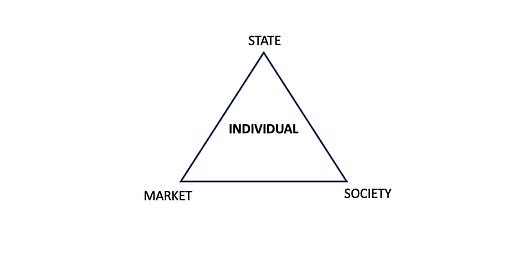Frameworks
Conventional wisdom often revolves around two significant institutions that impact an individual's daily life: the state and market. In this perspective, the state is frequently regarded as a driver of social reform, particularly in the Indian context. However, a more nuanced approach suggests considering three agents of change rather than just two.
Any individual is part of three meta-institutions, each with its own unique characteristics, follies, and strengths. These are state, market, and society.
(This framework is adopted from the works of Pranay Kotasthane).
State
The state, the most conspicuous among these actors, possesses its own set of strengths and weaknesses. One of its key strengths lies in ensuring the safety and security of its citizens. To achieve this objective, the state employs a combination of rules, regulations, and, notably, its monopoly on force.
However, the state also grapples with certain shortcomings. For instance, efficiently managing and allocating resources poses a challenge to the state. Similarly, accounting for the evolving and diverse interests of various individuals is something that the state is not good at.
Market
On the other hand, markets are very efficient. They provide the individual with the opportunity to be productive and innovative. It accounts for the diverse interests of people and evolves itself, keeping pace with the times. Markets operate through the medium of trade. Trade benefits all and creates positive-sum games.
But markets are oblivious to the concerns related to equity. Markets also fail to satisfy an individual's need for belonging.
Society
Lastly, society, among other things, fulfils an individual's need for belonging. It provides a framework of norms and values for the individual. Society also corrects the failures of governments and markets. It plugs government failures through acts like philanthropy and social reforms. It corrects market failures through acts like community management of resources.
But societies fail too. They are susceptible to majoritarianism, tend to be conservative, can suppress individual expression, etc.
The state, market, and society framework must encourage us to consider all these actors while thinking about policies. We need to extract benefits from all these institutions while one covers for the failures of the other.
As India became independent, our state took on the role of a social reformer. This was required at a time when society was fragmented and peace was elusive. But the state kept on adding to its responsibilities as a social reformer, pushing society away from what it does best. Similarly, the Indian state is in the business of producing and distributing resources, although this is best left for the markets. While it is tempting for the state to do everything, the individual is most benefited when each actor does what they are good at.
Thumb Rule: There are three institutions of change wrt an Individual - state, markets and society.




